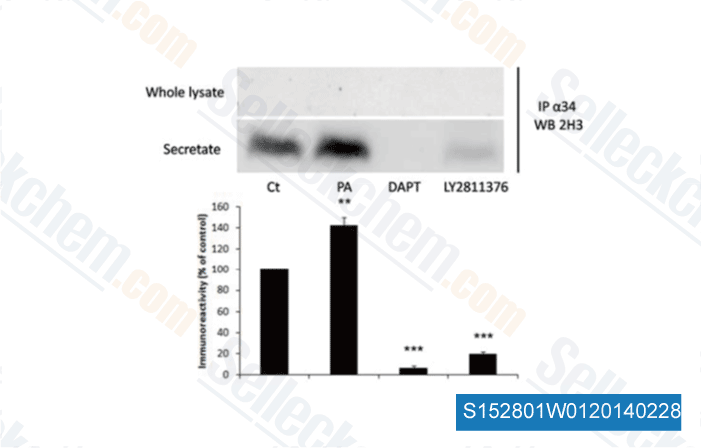|
How to Cite 1. For In-Text Citation (Materials & Methods): 2. For Key Resources Table: |
||
|
Toll Free: (877) 796-6397 -- USA and Canada only -- |
Fax: +1-832-582-8590 Orders: +1-832-582-8158 |
Tech Support: +1-832-582-8158 Ext:3 Please provide your Order Number in the email. We strive to reply to |
Technical Data
| Formula | C15H14F2N4S |
||||||||||
| Molecular Weight | 320.36 | CAS No. | 1194044-20-6 | ||||||||
| Solubility (25°C)* | In vitro | Ethanol | 64 mg/mL (199.77 mM) | ||||||||
| DMSO | 16 mg/mL (49.94 mM) | ||||||||||
| Water | Insoluble | ||||||||||
| In vivo (Add solvents to the product individually and in order) |
|
||||||||||
|
* <1 mg/ml means slightly soluble or insoluble. * Please note that Selleck tests the solubility of all compounds in-house, and the actual solubility may differ slightly from published values. This is normal and is due to slight batch-to-batch variations. * Room temperature shipping (Stability testing shows this product can be shipped without any cooling measures.) |
|||||||||||
Preparing Stock Solutions
Biological Activity
| Description | LY2811376 is the first orally available non-peptidic β-secretase(BACE1) inhibitor with IC50 of 239 nM-249 nM, that act to decrease Aβ secretion with EC50 of 300 nM, demonstrated to have 10-fold selectivity towards BACE1 over BACE2, and more than 50-fold inhibition over other aspartic proteases including cathepsin D, pepsin, or renin. Phase 1. | ||||
|---|---|---|---|---|---|
| Targets |
|
||||
| In vitro | LY2811376 demonstrates concentration-dependent inhibition of hBACE1 with an IC50 of 239 and 249 nM against a small synthetic peptide or a larger chimeric protein substrate, respectively. This compound treatment yields a concentration-dependent decrease in Aβ secretion in APP-overexpressing HEK293 cells. It inhibits Aβ secretion with EC50 of ~100 nM in primary neuronal cultures of PDAPP transgenic mouse. [1] | ||||
| In vivo | Administration of LY2811376 (10, 30, and 100 mg/kg doses) results in dose-dependent, significant reductions in Aβ, as well as sAPPβ and C99, the proximal cleavage products of APP proteolysis by BACE1 in APPV717F mouse model of Aβ pathology. After treatment with this compound (5 mg/kg), reductions in Aβ1-x are observed in plasma, with a maximal 85% reduction observed from 4 to 12 h after dosing in beagle dogs. [1] | ||||
| Features | Approximately 10-fold selectivity toward BACE1 over BACE2. |
Protocol (from reference)
| Kinase Assay: |
|
|---|---|
| Cell Assay: |
|
| Animal Study: |
|
References
|
Customer Product Validation

-
Data from [ Neurobiol Aging , 2014 , 35(7), 1570-81 ]

-
Data from [ J Biol Chem , 2014 , 289(30), 20871-8 ]
Selleck's LY2811376 Has Been Cited by 20 Publications
| Interplay between APP and glypican-1 processing and α-synuclein aggregation in undifferentiated and differentiated human neural progenitor cells [ Glycobiology, 2023, 33(4):325-341] | PubMed: 36790131 |
| Tangeretin Inhibits BACE1 Activity and Attenuates Cognitive Impairments in AD Model Mice [ J Agric Food Chem, 2022, 70(5):1536-1546] | PubMed: 35084179 |
| Establishment and characterization of immortalized sweat gland myoepithelial cells [ Sci Rep, 2022, 12(1):7] | PubMed: 34997030 |
| A study of protein-drug interaction based on solvent-induced protein aggregation by fluorescence correlation spectroscopy [ Analyst, 2022, 10.1039/d2an00031h] | PubMed: 35253833 |
| Amyloidogenic Processing of Alzheimer's Disease β-amyloid Precursor Protein Induces Cellular Iron Retention [ Mol Psychiatry, 2020, 10.1038/s41380-020-0762-0] | PubMed: 32444869 |
| A novel human colon signet-ring cell carcinoma organoid line: establishment, characterization and application [ Carcinogenesis, 2020, 41(7):993-1004] | PubMed: 31740922 |
| Multiple BACE1 inhibitors abnormally increase the BACE1 protein level in neurons by prolonging its half-life. [ Alzheimers Dement, 2019, 15(9):1183-1194] | PubMed: 31416794 |
| A cellular complex of BACE1 and γ-secretase sequentially generates Aβ from its full-length precursor. [ J Cell Biol, 2019, 218(2):644-663] | PubMed: 30626721 |
| Elevated cleavage of neuregulin-1 by beta-secretase 1 in plasma of schizophrenia patients. [ Prog Neuropsychopharmacol Biol Psychiatry, 2019, 90:161-168] | PubMed: 30500411 |
| Neuregulin 3 Signaling Mediates Nicotine-Dependent Synaptic Plasticity in the Orbitofrontal Cortex and Cognition. [ Neuropsychopharmacology, 2018, 43(6):1343-1354] | PubMed: 29114105 |
RETURN POLICY
Selleck Chemical’s Unconditional Return Policy ensures a smooth online shopping experience for our customers. If you are in any way unsatisfied with your purchase, you may return any item(s) within 7 days of receiving it. In the event of product quality issues, either protocol related or product related problems, you may return any item(s) within 365 days from the original purchase date. Please follow the instructions below when returning products.
SHIPPING AND STORAGE
Selleck products are transported at room temperature. If you receive the product at room temperature, please rest assured, the Selleck Quality Inspection Department has conducted experiments to verify that the normal temperature placement of one month will not affect the biological activity of powder products. After collecting, please store the product according to the requirements described in the datasheet. Most Selleck products are stable under the recommended conditions.
NOT FOR HUMAN, VETERINARY DIAGNOSTIC OR THERAPEUTIC USE.
